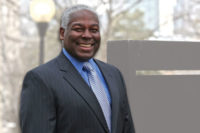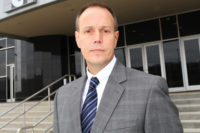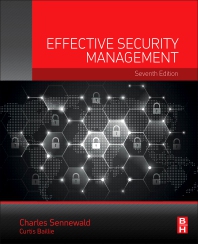Top Security Guarding Companies Report 2010
7th Annual Report: Who made the list?

There are tall orders for security officers at

Customer service is a primary business goal of security at Willis Tower. The doorman is a security officer and others in the lobby answer questions ranging from the size of the building to where’s the nearest McDonalds.
Best Image Forward
For Keith Kambic, director of security and life safety at Willis Tower, formerly known as Sears Tower but still the tallest building in the United States, there is nothing basic about his use of officers. “They are the face of our building,” Kambic says. “They are the first people you see on your way in and the last people you see on your way out. They leave a lasting impression.” So it is no wonder that the business of Willis Tower is the business of Kambic and his officers. Tenants, tourists, restaurants, stores and a world-recognized observation deck account for up to 20,000 people a day. “You just have to get people in and out smoothly, safely and securely,” he adds.For Daniel Brewer, construction manager, Habitat for Humanity of Omaha, his security officers have their feet closer to the ground but are just as business essential. The non-profit, which builds or renovates homes for people with very low incomes, fights site vandalism and theft with a contracted combination of technology and mobile, responding officers. His ROI is having assets, often donated by others, not disappearing, as a comfort and encouragement of future donations.
When Neal Armstrong, then deputy director of Homeland Security’s Customs and Border Protection (CBP) transportation program, faced cutbacks in transporting people caught illegally entering the U.S. at its southern border to detention facilities to await judicial review, he saw business value in contracting with a national guarding firm. The resulting collaboration between the federal agency and private contractor quickly developed into a successful partnership.
Partnership is the keyword in Chicago, Omaha, along the U.S.-Mexico border and everywhere there are security officers, especially those that are contracted. Says Cullen, “If you are going to outsource, above all determine if the service provider fits your culture and vision. And, if the relationship is not a partnership, it will not work.”
Kambic agrees and adds, “So many security executives, when they hire out, they keep hands off. That is counterproductive. Contracting officers is a relationship business. I do things. They do things.”
Willis Tower, a 110-story world-known landmark, is a security challenge. Just after the tragedy of 9-ll, security demands across the country amplified, and the cost related to securing buildings of this magnitude were ever increasing. Guests, visitors and tenants were screened and x-rayed before entering the building; security officers had a military-style approach; and customer service was not a priority. The security team looked to restructure and develop a world class solution that would help in controlling costs and set the standard for high rise security and life safety.

Security patrols the SkyDeck, the country’s highest public observation area, in the Willis Tower. There are security cameras but officers often pitch in to take tourist photos.
A New Way of Thinking
“We needed to change the mindset of security in our building after 9-11,” says Kambic. “AlliedBarton showed us that they could assist in controlling our costs, implementing the newest in technology and place a greater emphasis on security officer training and customer service.” Ron Skibinski of the service provider agrees. “Moving from a combined proprietary and contract program to a solely contract program helped to streamline operations, improve communications and control costs.” Skibinski knows the facility. He started working security at Willis Tower in 1974.“Contract security is a ‘no-brainer’ for me,” comments Kambic. “A contract service knows hiring, training and supervision; they do it all the time.” The final element is “to know my business.” When considering a vendor, he advises that price is somewhat important, “but I’m not a believer in choosing the lowest cost service. Look to see if the bid package is complete or if someone is trying to do a bait and switch. Carefully check that portfolio of references and, if a potential firm doesn’t come out to check your site carefully and completely, forget about it.”
"More companies are outsourcing with the hope of saving money and time," points out David Cullen, president of the consulting firm ISI - Intelligence Security International. Cullen also sees value in the chief security officer or security director checking out a service along a two-way street. “Go visit the local office of a firm you are evaluating.” There’s a lot to learn in checking out their digs.
In addition to basic training at Willis Tower, officers participate in monthly refresher training, often working with several agencies, including the Chicago Police and Fire departments and the Federal Bureau of Investigation. Emergency preparedness training days simulate actual emergencies and test the security staff. “It is important for our security officers to look at the big picture,” says Skibinski. “This refresher training prepares us for any and all emergencies -- small or large. We practice evacuations and response on a continual basis and it truly is beneficial for the entire staff.”
Having well-trained and responsive security officers starts with recruiting. “District Manager Mark Hubatch and recruiter Channa Bush have made my job very easy,” says Kambic. “They understand the type of applicant we need. Not only are we an office building, but we are also a top visitor destination. We set very high standards for our officers, and recruiting efforts have certainly found us the right people. We have a very hard working and dedicated team of more than 60 security officers. We are a family, plain and simple. Officers average five years of service, ten years for supervisors.”

Private security officers handle secured transportation services on the U.S.-Mexico border.
Photo courtesy of G4S Wackenhut
Photo courtesy of G4S Wackenhut
Public Assistance
A number of these security officers are on post at the building’s SkyDeck. “In the summer, wait times for the Skydeck can be lengthy at times and our security staff is challenged to take care of these guests, along with SkyDeck personnel. They answer questions from visitors from around the globe, assist in queue lines and screen all visitors as they head up to the viewing platform,” observes Kambic. The contract firm has shown ability to staff up or down depending on the flow of visitors. “Flexibility is important,” he insists.With the business firmly in mind, Willis Tower stressed the need to integrate more customer service into their security and life safety program. Officers live up to this request each day, as they open doors, call for cabs and greet tenants by name. “Our security officers act as customer service representatives and guests are often surprised to learn they are security officers,” comments Skibinski. Kambic helped that image along by dressing officers in two-piece tailored suits, while a doorman also dresses in a hotel-like outfit. “Willis Tower’s tenants see our team as helpful and approachable and our officers are sharp and attentive,” points out Skibinski. With a not-here attitude, Kambic says that too often security officers are “underappreciated and overworked.” For example, on an annual basis, after emergency response training, the security-Willis Tower partnership hosts a cookout and rewards picnic as well as an annual security officer appreciation breakfast where officers take part in team-building exercises and receive prizes.
Recognition is earned, however. “We test our security staff on a monthly basis with a ‘secret shopper’ program,” Kambic says. “The officers’ customer service skills are tested, and those who pass with the highest score are rewarded.” In addition, the building has implemented a Security Officer of the Month program, along with choosing the most outstanding Security Officer of the Year. Top building management can see the effort, and that business recognition pays off, too.
A trophy facility is also a target building with more pressure and demands as compared to traditional security assignments. For example, security officers must differentiate between tourist photographers and people potentially casing the facility. “But I must admit the fun is handling the tourists from around the world. They are often on vacation and in a great mood. And there is a new, interesting story every day,” comments Kambic.
In Omaha, Brewer’s Habitat for Humanity constructs homes for those in need; but, unfortunately, these projects are not immune to theft and vandalism. Like any other construction site, home construction can fall victim to theft of equipment, tools, supplies and vandalism. In the spring of last year, for instance, $50,000 worth of copper disappeared from one Omaha project. So Brewer partnered with Securitas Mobile, which began arming homes that were in the process of being built and completed homes that were awaiting a family with alarm systems, alarm response services and occasional patrol inspections. Since then, a number of incidents have been documented but the intruders were deterred, according to Brewer.

Technology complements officers on patrol. Using cellular telephones and global positioning, systems can route, track and verify people at work.
Tech and People, Too
Brewer bundles technology with officers. There’s a transportable, cellular security system with high performance wireless sensors which, when in alarm, alerts at a monitoring center which dispatches a roaming patrol officer in a vehicle. The bundle could also contain security video triggered by motion detection. “Basically, we learned about this from a corporate partner. Our business motivation was to prevent theft and loss due to damage” to assure donors, Brewer says.Consultant Cullen sees increasing value in such approaches. “To move away from the human side is impossible. You have to have a blend of technology and people.”
Security officers are also part of emerging public-private assignments, projects and partnerships in school districts, on city streets and police back offices and even along the U.S. border. In the latter application, responsibility for preventing illegal intruders crossing into the U.S. falls to the CBP. As America’s largest uniformed federal law enforcement organization, its role includes the detection and detention of huge numbers of people. Once apprehended, those men, women and children need to be processed and, in some cases, transported to detention facilities to await judicial review.
So a few years ago, the agency decided to outsource its transportation contract to G4S Wackenhut.
Once detained by CBP, the majority of the detainees are voluntarily returned to Mexico. Others are handed over to another DHS agency, Immigration and Customs Enforcement (ICE), for further processing. But “handed over” is not as simple as it sounds: It requires a transportation plan capable of collecting the prisoners – the detainees’ official designation – from a variety of points along the border and taking them safely and securely to the ICE centers. Later, they need to be transported once more to their point of release, back across the border.
The private security firm provides a combination of security officers and secure transportation which serve nine locations along the southwest border. Today, a team of more than 600 security officers operates more than 100 buses and vans.

Many security officers now use intelligent guard tour systems which can reflect a specific walk-around, verify stops along the way and aid in billing.
Critical Education and Training
No matter if the assignment is 110 stories up, on an Omaha street or along the U.S.-Mexico border, education and training of security officers is even more crucial today.The role of a security officer has become much more complex than it was back when “security” meant the night watchman who checked doors at an office building, particularly since 9/11. The night watchman had a job that called for minimal training. Today’s security officers have careers with advancement potential that demand education and training. These officers work in a broad range of industries, businesses, academic settings, military installations, war zones and more, according to Sandi J. Davies of the International Foundation for Protection Officers (IFPO).
“Know your audience is a cardinal rule in business that is often repeated, sometimes heeded, and often deeply regretted when it is ignored,” says Davies. “Not knowing what roles the officers fill or what tasks they perform can result in injury, loss of data and property, a breach of national security and even death if they are not properly trained for what they do. The need for current job delineation research for the security industry has never been greater, as the market for qualified security officers continues to grow and the roles expand.”
The only reliable way to get the right training to the right officers is to ensure there is current valid information about all the roles security officers now perform and the individual tasks involved in carrying out those roles. What do they do? How do they do it? What technologies do they use to do it? Dependable answers to these questions can be obtained through valid, independent research, points out the IFPO executive director. That research can then be analyzed to produce guidelines for effective training, which leads to the equation:
• Research + Job Delineation
• + Program Development
• + Relevant Training and Education with Proof of Training
• = Qualified Security Officers
“Unfortunately, the first part of the equation is missing in the security industry,” Davies says. “While there is research about the industry in general, there is no current research available about the roles of security officers or the tasks they perform. We must take the guesswork out of the equation; we must make research a priority; and we must ensure that the training is applicable to the tasks they will perform. Proof of training is the final vital component to ensure that, when officers are hired, they do indeed have the right knowledge to perform safely and effectively,” she contends.
Almost Robo-Cop
In addition to training, there are tech tools in the hands of officers or at the guarding firm’s office that can make a business difference.The hand-held computerized system is an invaluable management tool in a variety of environments. With its multiple tour capabilities, integrated functions and reporting options, it can deliver a convenient and cost-effective solution for security professionals. For example, a computerized PowerCheck guard tour system from Morse Watchmans is a hand-held data recorder, checkpoint stations, and reporting software. The data recorder allows security personnel to input incident codes on site, using the built-in keypad and display. Software converts the data recorder information into custom reports.
In a more encompassing way, geofencing has improved officer productivity for end-users while also saving more for guarding firms.
An example is in use at Bayer Protective Services of Sacramento, Calif., which now has a tech way to route, track and verify officers in vehicles to improve efficiency and offer clients a sizeable return on their investment.
Before implementing the new technology called TeleNav Track, the company had no way to provide its clients with a measurable ROI. In addition, clients would voice concerns about rarely seeing their assigned security officers and money was being lost due to timecard rounding because Bayer had no way to hold its employees accountable. Further inefficiencies and unnecessary expenditures were created by patrol officers using paper maps to navigate to client sites and through the manual dispatching of patrol officers.
Now the company has reduced labor and vehicle-related expenses. What used to cost $10,000 a month is now only $2,000. And, with geofencing, shift reports and break/lunch tracking, the company is able to monitor where officers are in real-time.
Security Officers: By the Numbers
Security officers patrol and inspect property to protect against fire, theft, vandalism, terrorism, and illegal activity. They protect people and assets; enforce the enterprise’s rules, regulations and laws on the property; deter criminal activity; and handle other assignments and problems.These workers may be armed. They use various forms of telecommunications to call for assistance from private monitoring, police, fire, or emergency medical services. They also operate and monitor sophisticated electronic access control, intrusion and security video systems. Security officers write comprehensive reports outlining their observations and activities during their assigned shift. They also may interview witnesses or victims, prepare case reports, and testify in court.
The security officer's job responsibilities vary from one employer or site to another. Most states require that officers be licensed. Individuals must usually be at least 18 years old, pass a background check, and complete classroom training in such subjects as property rights, emergency procedures, and detention of suspected criminals. Drug testing often is required and may be ongoing and random. Officers who carry weapons must be licensed by the appropriate government authority, and some receive further certification as special police officers, allowing them to make limited types of arrests while on duty. Armed positions also have more stringent background checks, training and entry requirements.
The need for security officers, according to the U.S. Department of Labor, will continue to grow strongly.
|
Occupation Title |
Employment 2008 |
Projected Employment 2018 |
Change 2008-18 |
|
Total Security Officers |
1,086,000 |
1,239,500 |
14% |
|
Gaming Officers |
9,300 |
10,400 |
12% |
|
Security Officers |
1,076,600 |
1,229.100 |
14% |
It’s a Business Decision
Proprietary or contract; how many officers; amount and types of training; level of supervision; kinds of tools assigned. These and other elements of employing security officers are really part of a business decision that almost always goes beyond price or wage level. Security leaders should have:• Vision for what officers do now and later.
• An understanding of the enterprise’s culture as it relates to security officers.
• Details of what risks exist today and in the future.
• Knowledge of the job’s responsibilities beyond security.
• Insight into the positive impact of technology for or used by officers.
• Recognition and incentive programs.
• Strong, ongoing in-house and outside training.
Links
Looking for a reprint of this article?
From high-res PDFs to custom plaques, order your copy today!









